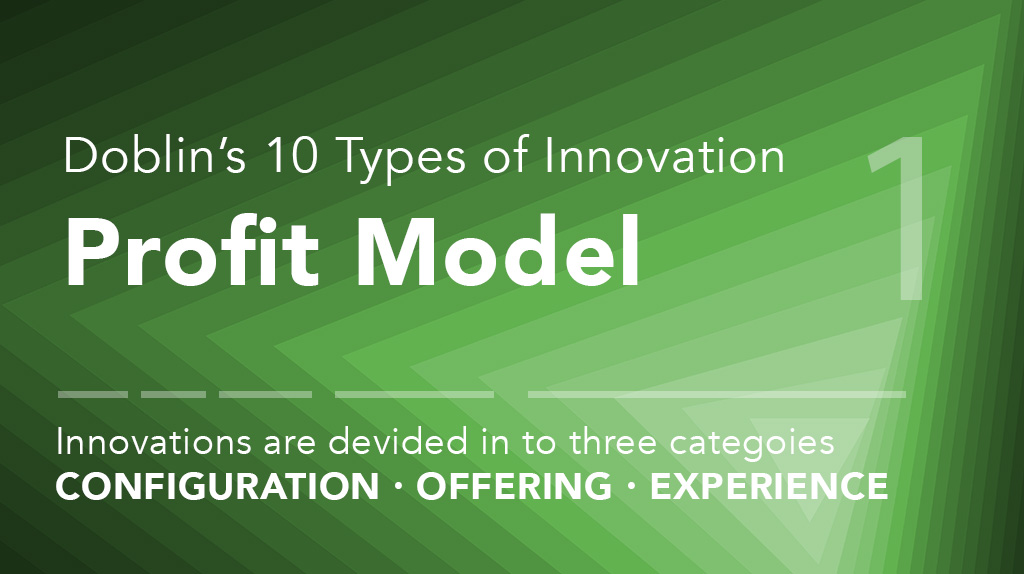Intro
In this series of posts, we will be inspecting Doblin’s 10 Types of Innovation, a popular framework for analyzing innovations in business developed by the Doblin Innovation Firm in Chicago. Innovations are divided into three categories: configuration, offering, and experience. Configuration focuses on the innermost workings of an enterprise and its business system, offering focuses on an enterprise’s core product or service, and experience focuses on customer-facing elements. In this post, we will analyze the first block in configuration, profit model innovation.
Definition
Profit Model Innovation is essentially about a how firm makes money. Doblin defines profit model innovation as:
“Innovative profit models find a fresh way to convert a firm’s offerings and other sources of value into cash. Great ones reflect a deep understanding of what customers and users actually cherish and where new revenue or pricing opportunities might lie. Innovative profit models often challenge an industry’s tired old assumptions about what to offer, what to charge, or how to collect revenues. This is a big part of their power: in most industries the dominant profit model often goes unquestioned for decades.”
Profit model innovation is sometimes referred to as business model innovation. Boston Consulting Group emphasizes enhancing advantages and creating value by making simultaneous changes to an organization’s value proposition and its operating model. They highlight three specific opportunities: where to play along the value chain, what cost model is needed to ensure attractive returns, and what organizational structure and capabilities are essential to success. Harvard Business Review argues that profit model innovation isn’t always about new technologies or new markets. Most of the time, it’s about finding new ways to deliver existing products made from existing technology to existing markets.
Examples
Profit model innovation can happen anywhere along the value chain. One common example is premium pricing, where companies strategize how to charge more for their products than their competitors do. Larger, incumbent competitors may have profit models where they not only enforce premium pricing, they also use subscriptions to make it difficult for existing customers to switch. Meanwhile, new entrants may lower their prices dramatically in order to entice customers to use their products. O’Reilly insists that there is one constant: “to succeed, profit models—perhaps more than any other type of innovation—must align with a company’s overarching strategy and innovation intent.”
Maintaining Competitiveness
These companies were incumbents and used their profit model innovations to maintain their status as top competitors.
Rolls-Royce
Rolls-Royce is a British engineering company famous for their luxury cars and airplane engines. While previously they sold their airplane engines in a one-time sale, Rolls-Royce pioneered a new business model dubbed “power-by-the-hour” where airlines paid only for the operating hours on the engines and Rolls-Royce retained ownership and were responsible for maintenance and repair. This business model not only created advantages for itself and its customers, it allowed for the creation of low-cost airlines like Southwest.

Dow Corning
Dow Corning is a U.S. chemical company that specializes in silicone and silicon-based technology. Their business model was originally based around sales with extensive consulting services and high margins, but when sales began to stagnate after the commoditization of the silicone market, Dow Corning developed a cost-based “no frills” business model to cater to mass market customer groups who don’t require hands-on support. Dow Corning was able to capitalize on this new profit model innovation and to this day remains the largest producer of silicone products in the world.

Walmart
Walmart is an American multinational retail corporation that operates a chain of hypermarkets, discount department stores, and grocery stores. Led by the singular goal of providing “Every Day Low Prices,” Walmart has focused nearly all aspects of their profit model around this goal, focusing on improving efficiencies in sourcing, supply chain management, customer experience, distribution, and logistics. As a result, they are a great example of a company whose profit model reflects their overarching strategy.

Disrupting and Innovating
These institutions disrupted industries or innovated unique ways to capture profits.
Dell
Dell is a US company founded in 1984 that develops, sells, repairs, and supports computers. From their inception through the 1990s, personal computers were commonly sold to consumers through retail and reseller stores. Dell capitalized on the emerging Internet to sell and distribute computers directly to consumers, causing a fundamental shift in the way computers, and consumer goods in general, were sold.

Saint John’s University
Saint John’s University is a private, Roman Catholic higher education institution in Minnesota. They developed an innovative way to fund their sustainability projects, balancing immediate savings with zero interest loans in order to create a “snowball effect” for overall spending. Saint John’s University is an example of how profit model innovation does not necessarily have to mean profit in a literal sense and can instead be extended to how funding is structured.

Uber
Uber is an American technology company that disrupted the transportation industry by revolutionizing ride-sharing and bringing it to the masses through its smartphone app. Uber developed a profit model that could adapt in real time to local supply and demand and adjust costs accordingly. Many technology companies, especially ones that develop smartphone apps, have since adopted this type of profit model.

Netflix
Netflix is an American media company that provides over-the-top streaming content as well as DVD rental through mail. When Netflix expanded from their DVD rental service into streaming, they ported over their subscription profit model, allowing customers to watch unlimited content for a set monthly price. This radically disrupted the incumbent video on demand market (digital rentals) and fundamentally changed the way video content was consumed and paid for.

Techniques to Develop Profit Model Innovation
There are many different types of profit models and many ways to innovate, but these innovations all start from the same core question. “How do you create, deliver, and capture value?” How can we create new value? Can we deliver that value in a different way? Is there a way we can capture value more effectively? In the modern era, business models don’t last long. A company must constantly be reevaluating itself and its core assumptions.
Once a company has answers to these questions, it can start developing its profit model and innovating when necessary. Steps from this point forward may include producing a minimally viable product, ensuring that the profit model is properly scalable, and probing for weaknesses and possible failure points. It may also be helpful to search other industries to see if the same or a similar profit model is being used and determine what makes it work or not work.
The Harvard Business Review suggests three key questions as well: what mix of products or services should you offer, when should you make your key decisions, and why do key decision makers choose as they do? For product mix, companies can focus narrowly and capture more potential profits but take on significant risk or expand into adjacent spaces to reduce risk but possibly lose profits. The timing of key decisions and splitting them between decision makers can help reduce risk, while changing the order of decisions could lead to increased efficiency. Taking a look at key decision makers and how their motivations and incentives are aligned can streamline value chains and remove inefficiencies.
Impact
Profit model innovations can have a large effect on a company’s bottom line. For instance, the switch from a one-time sales model to a subscription model can ensure steady and consistent revenue month to month. One company that made this switch is Adobe, an American company known for their creative software like Photoshop. After years of selling their software traditionally, they switched to a subscription system called Creative Cloud in 2013. Since the change, Adobe has grown massively, regularly posting record-breaking profits.
For consumers, profit model innovations can save them money or increase convenience. When Netflix introduced its streaming platform, it upended the incumbent digital video market. Up until then, movies and television were either digitally purchased or rented, each time incurring a separate cost that could be anywhere between one dollar to twenty. Movie rentals also came with restrictions — for instance on iTunes, viewers had 30 days to start watching once rented and once they began had 48 hours to finish before the rental expired. Netflix introduced a model where for $8 a month, consumers could watch unlimited hours of content with virtually no restrictions. With this far more convenient option, consumers quickly realized that they could easily get their money’s worth and adapted their viewing habits so much that it gave rise to the term “binge watching.”
Conclusion
Profit model innovations can do everything from incrementally improve how a company captures profits all the way to disrupting entire industries. As we saw in the examples, profit model innovations have helped new companies establish themselves as dominant players, incumbents maintain their competitive edge, and at their most unique, changed the way we lived our lives.
Traditionally, a profit model innovation could sustain a company for years or even decades at a time. Now, with competition so fierce and technology evolving so rapidly, companies must always be continuously innovating in order to maintain relevance. Though it may be scary, companies that embrace change and new ideas will always be the ones best suited for the future. And who knows. The right profit model innovation may take you straight to the top.




